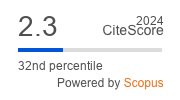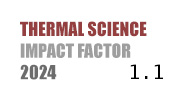ABSTRACT
This paper proposed a new heat dissipation structure with embedded both through silicon vias (TSV) and micro-channels to solve the complex heat problems of 3-D integrated circuits (3-D-IC). The COMSOL simulation model is established to investigate the characteristIC of steady-state response for the defined four cases. The simulation results show that our proposed heat dissipation structure (i.e., Case 4: 3-D-IC with embedded both TSV and micro-channels) can reduce steady-state temperature over 43.546%, 18.440%, and 12.338% in comparison Case 1 (i.e., 3-D-IC without embedded heat dissipation structure), Case 2 (i.e., 3-D-IC with only inserted TSV), and Case 3 (i.e., 3-D-IC with only embedded micro-channels), respectively. Besides, it is demonstrated that CNT as filler material of TSV and CNT nanofluid as coolant of micro-channels (i.e., the proposed Scheme 4) can further reduce steady-state temperature of 3D-IC with embedded our proposed heat dissipation structure. The corresponding results illustrated that the steady-state temperature of Scheme 4 is reduced by 13.767% as compared with Scheme 1 (i.e., the conventional Cu as filler material of TSV and water as coolant of micro-channels). Moreover, it is manifested that the heat transfer performance of 3-D-IC with embedded the proposed heat dissipation structure can be enhanced by the increase of TSV radius and flow rate of coolant of micro-channels. Therefore, our proposed heat dissipation structure has great prospect for enhancing heat transfer performance of 3-D-IC.
KEYWORDS
PAPER SUBMITTED: 2024-06-10
PAPER REVISED: 2024-07-30
PAPER ACCEPTED: 2024-08-12
PUBLISHED ONLINE: 2024-08-31
THERMAL SCIENCE YEAR
2025, VOLUME
29, ISSUE
Issue 2, PAGES [873 - 887]
- Che, F. X., et al., Reliability Study of 3-D IC Packaging Based on Through-Silicon Interposer (TSI) and Silicon-Less Interconnection Technology (SLIT) Using Finite Element Analysis, Microelectron. Reliab., 61 (2016), June, pp. 64-70
- Xu, P., Pan, Z.-L., Thermal Model for 3-D Integrated Circuits with Integrated MLGNR-Based through Silicon Via, Thermal Science, 24 (2020), 3B, pp. 2067-2075
- Coudrain, P., et al., Experimental Insights into Thermal Dissipation in TSV-Based 3-D Integrated Circuits, IEEE Des. Test, 33 (2016), 3, pp. 21-36
- Dhananjay, K., et al., Monolithic 3-D Integrated Circuits: Recent Trends and Future Prospects, IEEE Trans. Circuits Syst. II Express Briefs, 68 (2021), 3, pp. 837-843
- Ge, C., et al., Equivalent Thermal Conductivity Modelling of Through-Silicon Via (TSV) Structures, Proceedings, International Conference on Integrated Circuits, Technologies and Applications (ICTA), Beijing, China, 2018, pp. 164-165
- Savidis, I., et al., Electrical Modelling and Characterization of Through-Silicon Vias (TSV) for 3-D Integrated Circuits, Microelectron. J., 41 (2010), 1, pp. 9-16
- Barua, A., et al., Thermal Management in 3-D Integrated Circuits with Graphene Heat Spreaders, Phys. Procedia, 25 (2012), Apr., pp. 311-316
- Liu, Z., et al., Compact Lateral Thermal Resistance Model of TSV for Fast Finite-Difference Based Thermal Analysis of 3-D Stacked IC, IEEE Trans. Comput.-Aided Des. Integr. Circuits Syst., 33 (2014), 10, pp. 1490-1502
- Rakesh, B., et al., Simplistic Approach to Reduce Thermal Issues in 3-D IC Integration Technology, Mater. Today Proc., 45 (2021), Part 2, pp. 1399-1402
- Zhao, Y., et al., TSV Assignment of Thermal and Wirelength Optimization for 3-D-IC Routing, Proceedings, 28th International Symposium on Power and Timing Modelling, Optimization and Simulation (PATMOS), Platja d'Aro, Spain, 2018, pp. 155-162
- Salvi, S. S., Jain, A., A Review of Recent Research on Heat Transfer in 3-D Integrated Circuits (3-D IC), IEEE Trans. Compon. Packag. Manuf. Technol., 11 (2021), 5, pp. 802-821
- Lau, J. H., Yue, T. G., Thermal Management of 3-D IC Integration with TSV (through Silicon Via), Proceedings, 59th Electronic Components and Technology Conference, San Diego, Cal., USA, 2009, pp. 635-640
- Kandlikar, S. G., Review and Projections of Integrated Cooling Systems for 3-D Integrated Circuits, J. Electron. Packag., 136 (2014), 2, 024001
- Huang, H., et al., The Integration of Double-Layer Triangular Micro-Channel in 3-D Integrated Circuits for Enhancing Heat Transfer Performance, Case Stud. Therm. Eng., 58 (2024), 104363
- Kearney, D., et al., A Liquid Cooling Solution for Temperature Redistribution in 3-D IC Architectures, Microelectron. J., 43 (2012), 9, pp. 602-610
- Islam, S., Motaleb, I. A., Investigation of the Dynamic of Liquid Cooling of 3-D IC, Proceedings, 8th International Symposium on Next Generation ElectronIC (ISNE), Zhengzhou, China, 2019, pp. 1-3
- Xiao, C., et al., An Effective and Efficient Numerical Method for Thermal Management in 3-D Stacked Integrated Circuits, Appl. Therm. Eng., 121 (2017), July, pp. 200-209
- Hou, L., et al., A Novel Thermal-Aware Structure of TSV Cluster in 3-D IC, Microelectron. Eng., 153 (2016), Mar., pp. 110-116
- Zajac, P., et al., On the Applicability of Single-layer Integrated Micro-channel Cooling in 3-D IC, Proceedings, 19th International Conference on Thermal, Mechanical and Multi-PhysIC Simulation and Experiments in MicroelectronIC and Microsystems (EuroSimE), Toulouse, France, 2018, pp. 1-6
- Ali, W. A. F. W., et al., Numerical Study of Laminar Flow in Pillared-micro-channel, Proceedings, IEEE Regional Symposium on Micro and NanoelectronIC (RSM), Batu Ferringhi, Penang, Malaysia, 2017, pp. 71-74
- Song, D., et al., Optimization and Analysis of Micro-channels Under Complex Power Distribution in 3-D IC, IEEE Trans. Compon. Packag. Manuf. Technol., 12 (2022), 3, pp. 537-543
- Narayan, V., Yao, S.-C., Modelling and Optimization of Micro-Channel Heat Sinks for the Cooling of 3-D Stacked Integrated Circuits, Proceedings, Fluids and Thermal Systems, Advances for Process Industries, Parts A and B, Denver, Col., USA, , 2011, Vol. 6, pp. 999-1011
- Roy, S. K., et al., A Thermal Estimation Model for 3-D IC Using Liquid Cooled Micro-Channels and Thermal TSV, Proceedings, IFIP/IEEE International Conference on Very Large-scale Integration (VLSI-SoC), Daejeon, South Korea, 2015, pp. 122-127
- Qian, H., et al., Thermal Simulator of 3-D-IC with Modelling of Anisotropic TSV Conductance and Micro-channel Entrance Effects, Proceedings, 18th Asia and South Pacific Design Automation Conference (ASP-DAC), Yokohama, Japan, 2013, pp. 485-490
- Che, J., et al., Thermal Conductivity of Carbon Nanotubes, Nanotechnology, 11 (2000), 2, pp. 65-69
- Xia, G. D., et al., The CharacteristIC of Convective Heat Transfer in Micro-Channel Heat Sinks Using Al2O3 and TiO2 Nanofluids, Int. Commun. Heat Mass Transf., 76 (2016), Aug., pp. 256-264
- Lenin, R., et al., A Review of The Recent Progress on Thermal Conductivity of Nanofluid, J. Mol. Liq., 338 (2021), 116929
- Ahmadi, M. H., et al., A Review of Thermal Conductivity of Various Nanofluids, J. Mol. Liq., 265 (2018), Sept., pp. 181-188
- Farsad, E., et al., Numerical Simulation of Heat Transfer in a Micro-channel Heat Sinks Using Nanofluids, Heat Mass Transf., 47 (2011), 4, pp. 479-490
- Mizunuma, H., et al., Thermal Modelling and Analysis for 3-D IC with Integrated Micro-Channel Cooling, IEEE Trans, Comput.-Aided Des. Integr. Circuits Syst., 30 (2011), 9, pp. 1293-1306
- Koo, J.-M., et al., Integrated Micro-channel Cooling for 3-D Electronic Circuit Architectures, J. Heat Transf., 127 (2005), 1, pp. 49-58
- Wang, K.-J., et al., An Analytical Thermal Model for 3-D Integrated Circuits With Integrated Micro-Channel Cooling, Thermal Science, 21 (2017), 4, pp. 1601-1606
- Lienhard, J. H., Lienhard, J. H., A Heat Transfer Textbook, Dover Publications, Inc., Mineola, New York, USA, 2019
- Sridhar, A., et al., The 3-D-ICE: A Compact Thermal Model for Early-Stage Design of Liquid-Cooled IC, IEEE Trans. Comput., 63 (2014), 10, pp. 2576-2589
- Vajjha, R. S., et al., Measurements of Specific Heat and Density of Al2O3 Nanofluid, Proceedings, AIP Conference Proceedings, Bhubaneswar, India, 2008, pp. 361-370
- Simon, N., et al., Properties of Copper and Copper Alloys at Cryogenic Temperatures, Final Report, Report No. PB-92-172766/XAB, NIST/MONO-177, 5340308, 1992
- Ho, C. Y., et al., Thermal Conductivity of the Elements, J. Phys. Chem. Ref. Data, 1 (1972), 2, pp. 279-421
- White, G. K., Collocott, S. J., Heat Capacity of Reference Materials: Cu and W, J. Phys. Chem. Ref. Data, 13 (1984), 4, pp. 1251-1257
- White, G. K., Minges, M. L., Thermophysical Properties of Some Key Solids: An Update, Int. J. Thermophys., 18 (1997), 5, pp. 1269-1327
- Xie, H., et al., Thermal Diffusivity and Conductivity of Multiwalled Carbon Nanotube Arrays, Phys. Lett. A, 369 (2007), 1-2, pp. 120-123
- Subramaniam, C., et al., One Hundred Fold Increase in Current Carrying Capacity in a Carbon Nanotube-Copper Composite, Nat. Commun., 4 (2013), 1, 2202
- Azmi, W. H., et al., Correlations for Thermal Conductivity and Viscosity of Water Based Nanofluids, IOP Conf. Ser. Mater. Sci. Eng., 36 (2012), 012029
- Xue, Q. Z., Model for Thermal Conductivity of Carbon Nanotube-Based Composites, Phys. B Condens. Matter, 368 (2005), 1-4, pp. 302-307
- Xuan, Y., Roetzel, W., Conceptions for Heat Transfer Correlation of Nanofluids, Int. J. Heat Mass Transf., 43 (2000), 19, pp. 3701-3707
- Pak, B. C., Cho, Y. I., Hydrodynamic and Heat Transfer Study of Dispersed Fluids with Submicron Metallic Oxide Particles, Exp. Heat Transf., 11 (1998), 2, pp. 151-170
- Bello-Ochende, T., et al., Constructal Cooling Channels for Micro-Channel Heat Sinks, Int. J. Heat Mass Transf., 50 (2007), 21-22, pp. 4141-4150
- Xu, P., et al., Thermal Performance Analysis of Carbon Materials Based TSV in 3-D Integrated Circuits, IEEE Access, 11 (2023), July, pp. 75285-75294
- Wang, K., Pan, Z., Thermal Management of the Die Bonding Architecture in 3-D-IC, Proceedings, 3rd International Conference on Advances in Energy and Environmental Science 2015, Zhuhai, China, 2015
- Shiyanovskii, Y., et al., Analytical Modelling and Numerical Simulations of Temperature Field in TSV-based 3-D IC, Proceedings, International Symposium on Quality Electronic Design (ISQED), Santa Clara, Cal., USA, 2013, pp. 24-29
- Yoshida, K., Morigami, H., Thermal Properties of Diamond/Copper Composite Material, Microelectron. Reliab., 44 (2004), 2, pp. 303-308
- Shoji, Y., et al., Cross-Linked Liquid Crystalline Polyimides with Siloxane Units: Their Morphology and Thermal Diffusivity, Macromolecules, 46 (2013), 3, pp. 747-755
- Sun, J., et al., Thermal Dissipation Performance of Metal-Polymer Composite Heat Exchanger with V-Shape Microgrooves: A Numerical and Experimental Study, Appl. Therm. Eng., 121 (2017), July, pp. 492-500
- Jumpholkul, C., et al., An Experimental Study to Determine the Maximum Efficiency Index in Turbulent Flow of SiO2/Water Nanofluids, Int. J. Heat Mass Transf., 112 (2017), Sept., pp. 1113-1121
- Jia, Y., et al., PSpice-COMSOL-Based 3-D Electrothermal-Mechanical Modelling of IGBT Power Module, IEEE J. Emerg. Sel. Top. Power Electron., 8 (2020), 4, pp. 4173-4185

